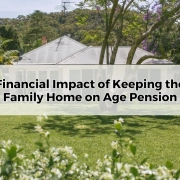How to Prioritise Financial Needs for Aged Care
Table of Contents
ToggleNavigating the financial complexities of aged care is an essential step in securing a comfortable and sustainable future. With an ageing population and increasing care costs, individuals and
families must proactively plan for the financial commitments associated with aged care.
Government policies, fluctuating economic conditions, and individual circumstances all play a role in shaping the best financial strategy. Taking a structured approach ensures that aged care
decisions are both financially viable and aligned with personal needs.
Assessing Immediate and Long-Term Care Needs
Determining the appropriate level of aged care requires a thorough evaluation of both current and future requirements. Immediate needs may include in-home assistance, modifications to the family home, or medical support, while long-term considerations often involve transitioning into residential aged care. Factors such as chronic health conditions, mobility challenges, and personal preferences influence the level of care required. A proactive approach, including discussions with healthcare professionals and financial advisers, allows individuals to anticipate potential costs and structure their finances accordingly.
Government Support and Subsidies
The Australian Government offers various financial support mechanisms for aged care services, including the Home Care Package (HCP) and Residential Aged Care subsidies. These
government contributions are determined through means testing, which assesses income and assets to establish the level of financial assistance an individual is entitled to. Understanding eligibility criteria and maximising available subsidies can significantly alleviate financial burdens. Seeking professional advice can assist in navigating the complexities of aged care funding and ensuring that all entitlements are fully utilised.
Personal Savings and Superannuation Strategies
Superannuation is a fundamental resource for funding aged care expenses. A well-structured approach to superannuation drawdowns and investment allocations can provide long-term
financial sustainability. Pension income, account-based pensions, and annuities should be managed strategically to maintain cash flow while minimising tax implications. Individuals must also consider the balance between preserving wealth for estate planning and meeting the costs of aged care services. Professional financial guidance ensures that superannuation is optimally
utilised to support aged care needs.
Downsizing and Asset Liquidation
For many individuals, the family home represents a significant financial asset that can be leveraged to fund aged care. Downsizing or selling the property can release substantial capital, yet this decision requires careful assessment of Centrelink implications, aged care means testing, and tax obligations. Alternative strategies, such as retaining the home and generating rental income, may provide financial benefits while preserving estate value. Engaging a financial adviser helps individuals weigh the pros and cons of asset liquidation while safeguarding financial stability.
Structuring Aged Care Fees and Payment Options
Aged care facilities impose various costs, including refundable accommodation deposits (RADs), daily accommodation payments (DAPs), and additional service fees. Understanding the differences between lump sum payments and ongoing fees enables individuals to select the most cost-effective approach. Factors such as liquidity, investment returns, and pension eligibility must be considered when determining how to structure aged care payments. A clear financial strategy helps mitigate financial stress and ensures affordability without compromising care quality.
Estate Planning and Wealth Preservation
Aged care financial planning should align with broader estate planning objectives. Wills, enduring powers of attorney, and trusts play a critical role in managing wealth and ensuring that assets are distributed according to personal wishes. Additionally, structuring financial arrangements in a way that minimises aged care costs while protecting inheritance for beneficiaries is essential. Estate planning strategies must be regularly reviewed to reflect changing financial circumstances, tax laws, and aged care regulations.
Impact of Gifting and Financial Transactions
Many individuals consider gifting assets to family members to reduce assessable assets for aged care means testing. However, gifting can have unintended consequences, including reductions in government benefits and increased personal financial risk. Centrelink applies strict gifting rules, which may affect pension entitlements and aged care fee calculations. Before making significant financial transactions, it is crucial to seek expert advice to ensure that gifting strategies align with overall financial goals and do not create adverse financial outcomes.
Tax Considerations in Aged Care Planning
Tax implications play a significant role in aged care financial planning. Capital gains tax (CGT) may apply when selling assets, while income tax on superannuation withdrawals can affect cash
flow and affordability. Deductible expenses related to aged care, such as medical costs and accommodation fees, can be leveraged to optimise tax efficiency. Understanding the interplay between tax liabilities and aged care costs enables individuals to make informed decisions that minimise financial strain and maximise benefits.
Role of Financial Advisers in Aged Care Planning
Engaging a financial adviser with expertise in aged care ensures that individuals receive tailored strategies to navigate the complexities of aged care funding. Aged care specialists assist in
structuring payments, maximising government support, and aligning financial plans with personal and family goals. The intricate nature of aged care finance makes professional guidance invaluable in avoiding costly mistakes, optimising asset management, and securing financial stability throughout the aged care journey.
Evaluating Aged Care Facility Costs and Services
Choosing the right aged care facility involves more than just financial considerations. Facilities vary in cost structures, service inclusions, and quality of care, making comprehensive research
essential. Comparing accommodation pricing, daily fees, and optional extras allows individuals to select a facility that meets both care needs and budgetary constraints. Understanding contractual agreements and fee structures ensures transparency and prevents unexpected financial obligations.
Contingency Planning for Unexpected Costs
Unexpected financial challenges, such as deteriorating health conditions or increased care requirements, can arise at any time. Establishing a contingency plan ensures that individuals
are financially prepared for unforeseen circumstances. Setting aside emergency funds, exploring insurance options, and maintaining financial flexibility provide security and peace of mind. Aged care financial plans should be adaptable to accommodate changing needs without compromising financial well-being.
Regular Review and Adjustment of Financial Strategies
Aged care financial planning is not a one-time exercise. Regular reviews are necessary to account for changes in personal circumstances, government policies, and financial markets.
Revisiting financial strategies ensures that individuals remain on track to meet aged care costs while optimising benefits and entitlements. Partnering with a financial adviser for periodic
assessments and adjustments keeps aged care plans aligned with evolving needs and objectives.
By prioritising financial needs strategically, individuals can secure quality aged care solutions without unnecessary financial strain. Thoughtful planning, informed decision-making, and professional guidance empower individuals and families to navigate aged care finance with confidence and clarity.









